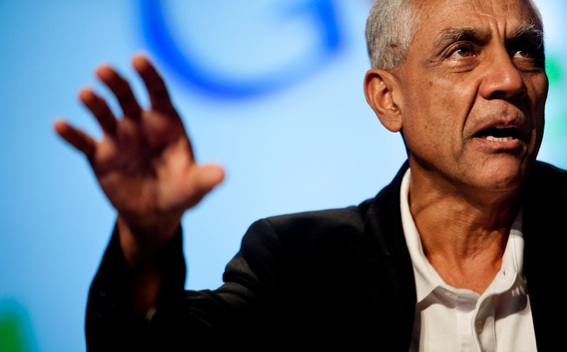Editor’s note: This is Part I of a three-part guest post written by legendary Silicon Valley investor Vinod Khosla, the founder of Khosla Ventures. In Part II, he will describe how software and mobile technologies can augment and even replace doctors. In Part III, he will talk about how technology will sweep through education.
I read the following in a NY Post article last year by Google’s research chief Peter Norvig:
Forty years ago this December, President Nixon declared a war on cancer, pledging a “total national commitment” to conquering the disease. Fifty years ago this spring, President Kennedy declared a space race, promising to land a man safely on the moon before the end of the decade. And 54 years ago, Artificial Intelligence pioneer Herbert Simon declared “there are now in the world machines that think” and predicted that a computer would be world chess champion within 10 years.
Though we made it to the moon the efforts in cancer and artificial intelligence have failed in their larger ambitions but have made progress. In cancer:
Those hoping for a single “cure” were disappointed because cancer turned out to be not a single problem but a complex arrangement of inter-related problems on which we continue to make incremental progress.
Artificial intelligence turned out to be more like cancer research than a moon shot. We don’t have HAL 9000, C-3PO, Commander Data, or the other androids imagined in the movies, but A.I. technology touches our lives many times every day…
A.I. touches our lives in the form of chess computers that are better than most humans, computers beating the best humans at Jeopardy, intelligent ad targeting, Microsoft Kinect recognizing human motion and even amazingly, Google’s self-driving car that drove itself from San Francisco to Los Angeles. Intelligent systems can even do transactions involving judgment like investing on Wall Street (a former MIT mathematician is now a hero on Wall Street with one of the best performing investment funds for many years in this judgment-based domain) and of course Siri’s conversational interface that does what you ask (mostly—think of Gen 1.0 as a high-IQ three-year old getting better with each passing year). Computer Jeopardy champions, self-driving cars and Siri-like conversational interfaces would have seemed very hard a few years ago.
Rather than the brute force logic-based development that was envisioned with Commander Data, successful systems have been built from examples rather than logical rules. We essentially let the computer “figure it out” using lots of past problems and solutions that include probability assessment systems beyond any hard-coded rules. Reasoning under uncertain conditions underlies a major area of recent progress.
Where will these advances in computing lead us in the next decade? A few other thoughts are worth adding:
i) a post on bionic software defined as one that combines the biological and mechanical systems to create an enhanced system that is more powerful than either alone. “Bionic software,” in this sense, is the interplay of humans and computers augmenting each other’s actions and amplifying one another’s understanding (for a while at least, they can help and complement each other);
ii) a recent Forrester assessment that the iPad 2 in 1993 would be considered one of the top 30 most powerful computers on the planet and similar to a Cray supercomputer from 1986.
iii) An Nvidia graphics chip designed primarily for video games today can be assembled into a five teraflop machine for less than $25,000 and can happily run powerful new programs (among many other types) called “self organizing machines” that determine the how (algorithms for geeks) if told the “what” (examples of right/wrong medical diagnosis or fraudulent transactions or unusual patterns of behavior or symptoms, for example).
iv) finally, the fashion in big data in the venture capital business has injected a lot of new energy and exploration for using experts and expert systems, probability and statistics, machine learning, self organizing machines and many less-discussed and some yet-undisclosed systems. (Those stock traders seldom talk about what their computerized trading systems do, nor do the spooks or Google in its spam filtering algorithms). Data, and big data especially hold “truths & likely correlations” well beyond the biases of your average doctor, and unaffected by the distortions of pharmaceutical marketing and selective medical study reporting, or a desire to make more money, or other intentional and unintentional human failings.
These are all incredible achievements in and of themselves, but the challenge for us now is to find their logical synthesis in the marketplace of ideas and convergence in the flow of time. In other words, so what? With this blog post series, I’m exploring a few of the things that I think come out of this.
Quoting another writer:
You probably hate the idea that human judgment can be improved or even replaced by machines, but you probably hate hurricanes and earthquakes too. The rise of machines is just as inevitable and just as indifferent to your hatred.
My two bits: it will improve health care and education, especially for those who can least afford it, and make the world a more humanitarian place. And no, your typical doctor or teacher may have a better, more human role being a mentor, friend and advisor, at least for a while. They will have more time for you.
I will elaborate in my next post.
